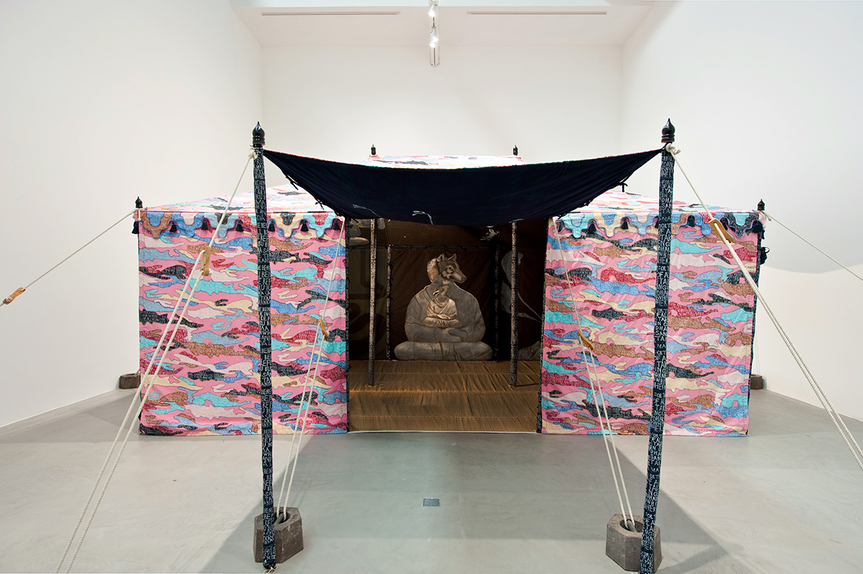
R
E
V N
E
X
T
Installation view of “Francesco Clemente: Encampment” at Carriageworks, Sydney, 2016. Courtesy Carriageworks.
In the winter of 2009 I was on a bus negotiating what was then little more than a snow covered mud road from Huanglong to the World Heritage Site of Jiuzhaigou in the north of China’s Sichuan Province. There were various peaks and valleys and the driver careened through the bends with abandon, protected by a plethora of prayer flags draped across the windscreen. At the side of the road were road gangs camped in numerous tents that, above the snow line, steamed in the bitter cold. As darkness fell the tents took on a curiously and yet familiar transparency as their inhabitants cast mystical moving shadows on the glowing canvas.
I was recently reminded of this at Sydney’s historic exhibition space Carriageworks, where Italian artist Francesco Clemente’s Encampment (2012–14) displayed a series of six large-scale, highly-ornate handmade tents that spread through the old factory space, anchored to the concrete floor by heavy industrial iron weights. The tents were liveried in camouflage designs made from wood block prints, and embellished with narrative designs with each piece edged with golden thread. The tent poles had highly polished finials and the roofline was draped in coiffured tassels. Nina Miall the curator of the exhibition confessed to having spent hours brushing these tassels. “It was a kind of therapy,” she said.
Clemente saw many of these camouflage tents in and around Rajasthan in India, because of the country’s borders with Pakistan and the strong military presence there. “The tents are everywhere,” Clemente said at the Carriageworks media preview. He spoke to a tent specialist and said that he wanted these camouflaged exteriors, but in a range of colors, and for the exteriors to be embellished with arcane and esoteric symbols and magic numbers that blend Western and Indian influences. After spending many years visiting and working in India, these part abstract, part figurative symbols have become part of his iconography.
The tents of Clement’s Encampment are a paean to collaboration; he worked with local wood-block printers in Rajasthan and an artisan from the same area to machine-stitch all the tents. But Clemente painted the interiors of the tents himself in washed tempera with a range of erotically charged allusive stories. Physical love, bodily pleasure and tales of spiritual reincarnation flood the interiors in lush drifts of color alongside images of skeletons that could have been plucked from the Mexican Day of the Dead celebrations and mummified Egyptian cats in what can be described as a crazy melange of illustrations. There are self-portraits, too, with one tent dedicated to the artist’s wizened face that shows his spiky whiskers and hair peering out among the designs with an inscrutable and mystical curiosity.
There is a great deal of nostalgia in Clemente’s designs, and a sense of closing the circle of life that comes to those of a certain age. Clemente is 64— not “old,” but of an age where one would have had accrued wisdom. I asked him about his life journey, which has given him the sobriquet of a nomadic artist. For 30 years he has divided his time between New York and Varanasi. India gives him spiritual fulfilment, while New York provides grounding in city life. “Although you should never underestimate the spirituality of New York,” he said.
Before Sydney he was in Siena, after Sydney it would be Hong Kong and Beijing for several weeks before heading back to India and New York. “Many years ago I decided to escape into a global geographic narrative (rather than an historic one in Europe). I began a nomadic life between America and India. The tents offer some of those experiences through the years, they are literal and explicit references to my way of life.” He adds, “The value of images is that they take you on a journey, moving towards enlightenment. “You get emptier and emptier and you exist through the eyes of the people around you. Personal relationships become more important than the relationships with art,” he said.
Complementing the tents is a series of watercolors inspired by the jewel-like qualities of Mughal painting but instead of the precise delineation of Mughal art, Clemente bleeds his washes into one another and pushes his figuration to wonderful abstract limits.
“Francesco Clemente: Encampment” is currently on view at Carriageworks, Sydney, until October 9, 2016.







